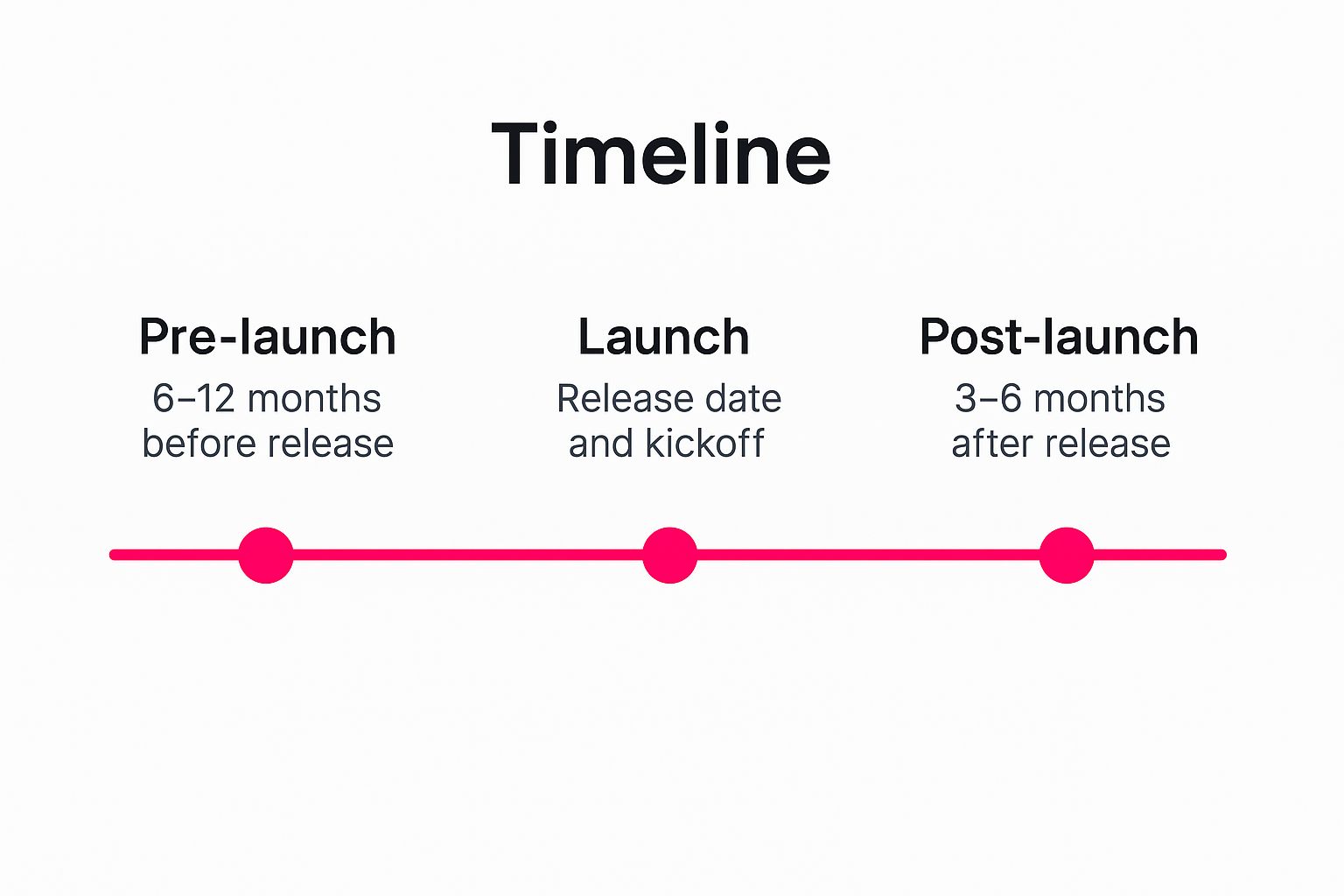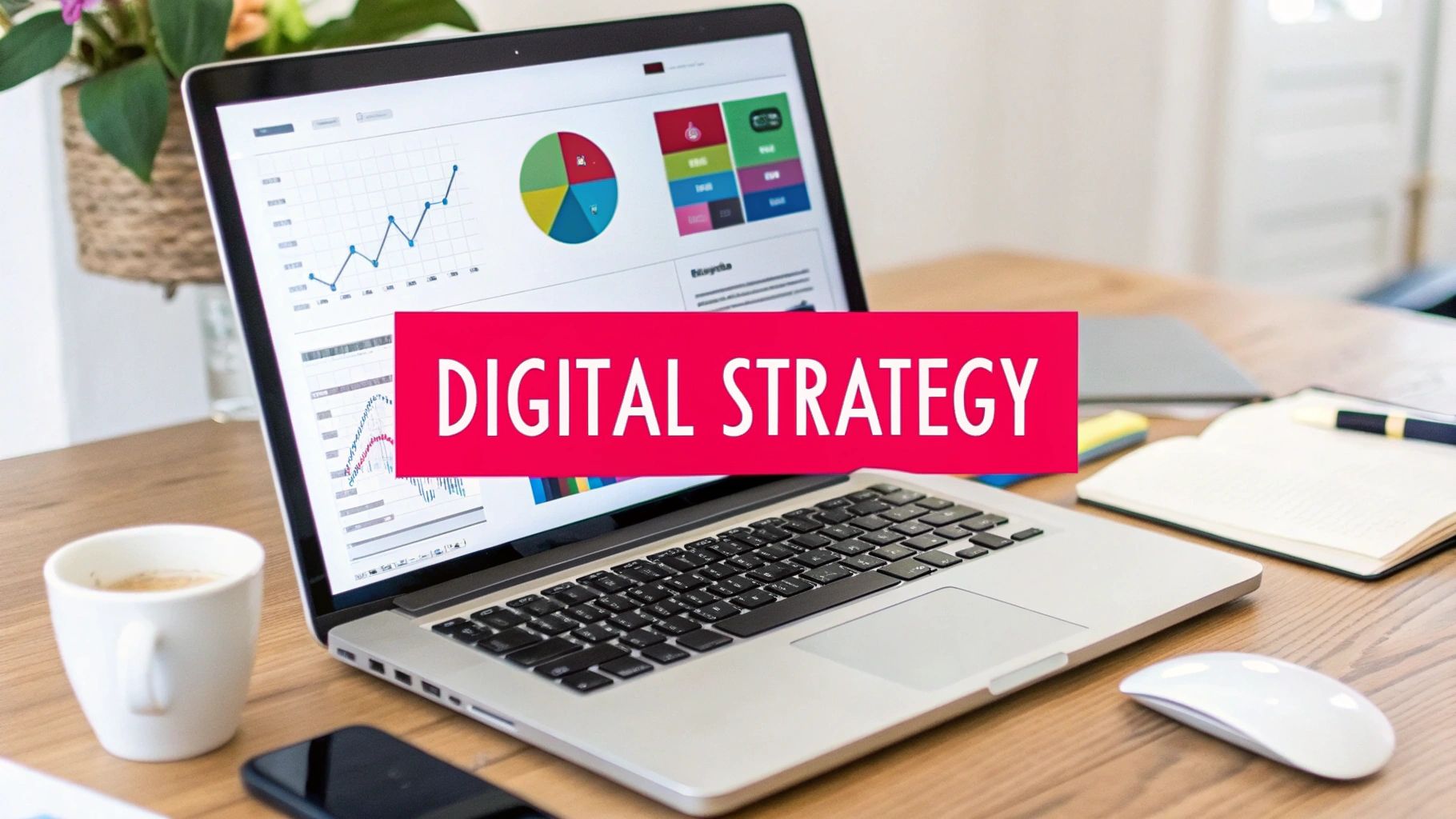Unlocking Success: Decoding Winning Marketing Plans
Need a marketing plan example? This listicle provides seven detailed examples across various industries to guide your 2025 strategy. We'll dissect winning campaigns, revealing the core elements that drive success. Learn how to define clear objectives, implement effective strategies, and choose the right tactics. We'll also cover budget allocation and performance measurement, providing actionable insights you can apply immediately.
Understanding these components is crucial for achieving your marketing goals. Whether you're launching a new product, building brand awareness, or driving sales, a solid marketing plan is essential. This guide helps you translate theory into practice, providing concrete marketing plan examples you can adapt to your specific needs. We'll move beyond generic success stories, offering deep strategic analysis and specific tactical insights.
We'll explore examples covering:
- Product launches
- Digital marketing strategies
- Content marketing campaigns
- Social media engagement
- Email marketing automation
- Influencer collaborations
- Event marketing
- Customer retention programs
Each marketing plan example will be broken down to reveal the "why" behind its success, offering replicable strategies for startups, established businesses, and e-commerce retailers alike. We'll provide actionable takeaways focused on the UAE market and relevant to diverse business models, from B2B lead generation to boosting brand identity.
1. Product Launch Marketing Plan
A product launch marketing plan is a comprehensive framework designed to introduce a new product to the market. It encompasses pre-launch, launch, and post-launch phases, focusing on creating awareness, generating demand, and securing market position. This detailed plan coordinates marketing efforts across multiple channels for maximum impact. A well-executed product launch is crucial for early success and long-term market viability, making this a core marketing plan example.
Examples of Successful Product Launches
Apple’s iPhone launches exemplify successful product launch marketing. Coordinated media events generate immense pre-launch buzz. Targeted advertising campaigns and strategic retail partnerships ensure widespread availability and consumer excitement upon release. Similarly, Tesla uses pre-order campaigns and exclusive previews to build anticipation for new models, leveraging social media to amplify the message. Netflix leverages trailer campaigns, influencer partnerships, and cross-platform promotion to drive viewership for their original series. These "marketing plan example" successes highlight the power of a strategic launch.
Actionable Tips for Your Product Launch
- Plan Early: Start 6-12 months before your target launch date to allow ample time for each phase.
- Build Anticipation: Implement teaser campaigns to generate excitement and pre-launch demand.
- Coordinate with Sales: Ensure a seamless handoff between marketing and sales teams for smooth order fulfillment.
- Be Prepared: Develop contingency plans for potential delays or unexpected market shifts.
- Target Early Adopters: Focus initial marketing efforts on early adopters and brand advocates to build momentum.
- Bolster Customer Support: Prepare your customer support team for a potential influx of inquiries post-launch.
Why a Product Launch Plan Is Essential
A product launch marketing plan is crucial for maximizing your chances of success. It provides a structured approach to introduce your product, minimizing risks and capitalizing on opportunities. Without a comprehensive plan, even the most innovative products can fail to gain traction. By generating pre-launch buzz, coordinating marketing activities, and planning for post-launch engagement, you set the stage for sustainable growth. This "marketing plan example" is vital for any business introducing a new offering.

The infographic visualizes a timeline of a product launch, highlighting the pre-launch (6-12 months prior), launch (release date), and post-launch (3-6 months after) phases. The visualization emphasizes the importance of each stage in a successful product rollout, indicating the chronological flow of activities for a "marketing plan example". Each phase has specific tasks and objectives, ensuring a structured and effective launch process.
2. Digital Marketing Plan
A digital marketing plan is a comprehensive online marketing strategy. It leverages digital channels like social media, search engines, email, content marketing, and paid advertising to reach target audiences. This plan focuses on building online presence, driving website traffic, and converting digital interactions into tangible business results. A robust digital presence is essential in today's interconnected world, making this a crucial "marketing plan example".

Examples of Successful Digital Marketing
HubSpot's inbound marketing approach, utilizing educational content, SEO, and lead magnets, demonstrates the effectiveness of a well-rounded digital strategy. Dollar Shave Club's viral video campaign disrupted the razor market with its subscription model and engaging content. Airbnb's user-generated content and community-driven marketing built a global travel platform. These "marketing plan example" successes showcase the power of digital channels.
Actionable Tips for Your Digital Marketing Plan
- Develop Buyer Personas: Craft targeted messaging that resonates with your ideal customers.
- Create a Content Calendar: Ensure consistent posting and engagement across platforms.
- Use Marketing Automation: Streamline lead nurturing and improve conversion rates.
- Implement Tracking & Analytics: Monitor campaign performance and make data-driven decisions.
- Focus on Mobile Optimization: Cater to the growing mobile user base.
- Test and Optimize: Continuously refine your campaigns for maximum impact.
- Integrate Digital Channels: Create a seamless and cohesive brand experience.
Why a Digital Marketing Plan Is Essential
A digital marketing plan is essential for reaching and engaging your target audience online. It provides a structured framework for coordinating your efforts across various digital channels, maximizing your return on investment. Without a cohesive plan, your digital marketing efforts can become fragmented and ineffective. By focusing on a targeted approach, consistent engagement, and data-driven optimization, you establish a strong online presence and drive sustainable business growth. This "marketing plan example" is indispensable in the current digital landscape.
3. Content Marketing Plan
A content marketing plan is a strategic approach to creating, distributing, and promoting valuable, relevant content to attract and engage a target audience. It focuses on building brand authority, educating customers, and driving profitable customer actions. Unlike traditional advertising, content marketing provides value upfront, establishing trust and long-term relationships with your audience. This "marketing plan example" emphasizes consistent, high-quality content across various formats and channels, from blog posts and videos to social media updates and email newsletters.
Examples of Successful Content Marketing
Red Bull excels at content marketing by creating and sharing extreme sports content that aligns with its brand identity. This goes beyond simple product promotion, building a lifestyle brand that resonates with its target audience. Coca-Cola’s “Share a Coke” campaign effectively leveraged storytelling and personalization, creating shareable content that increased brand engagement. Microsoft provides extensive technical documentation and developer resources, establishing itself as a go-to source for technical expertise within its industry. These examples highlight the versatility and power of a well-executed content marketing strategy.
Actionable Tips for Your Content Marketing Plan
- Define Your Audience: Understand your target audience's needs, interests, and preferred content formats.
- Create a Content Calendar: Plan and schedule your content in advance to maintain consistency.
- Diversify Content Formats: Experiment with different formats, such as blog posts, videos, infographics, and podcasts.
- Promote Your Content: Share your content across multiple channels to reach a wider audience.
- Analyze and Optimize: Track your content's performance and adjust your strategy based on the data. Learn more about…
- Engage with Your Audience: Respond to comments and feedback to build community and foster relationships.
Why a Content Marketing Plan Is Essential
A content marketing plan is crucial for building a sustainable online presence. It provides a structured approach to content creation and distribution, ensuring your efforts align with your overall business goals. This "marketing plan example" helps establish your brand as a thought leader, attracts potential customers organically, and nurtures those leads through the sales funnel. By providing valuable content that addresses your audience's needs, you build trust and loyalty, ultimately driving conversions and long-term growth. Without a plan, your content efforts can be fragmented and ineffective, missing valuable opportunities to connect with your target market.
4. Social Media Marketing Plan
A social media marketing plan is a strategic framework for leveraging social media platforms to achieve specific business objectives. It encompasses platform selection, content strategy, community management, and paid social advertising to build brand awareness, engage with customers, drive website traffic, and generate leads or sales. This "marketing plan example" offers a powerful way to connect with your target audience where they already spend their time.

Examples of Successful Social Media Marketing
Wendy's has mastered Twitter with its witty personality and engaging customer interactions. Nike leverages Instagram storytelling and athlete partnerships to build a strong brand community. LinkedIn serves as a prime example of B2B thought leadership through a content-rich strategy. These successes demonstrate how a well-defined social media presence can drive business results, making them strong "marketing plan example" cases.
Actionable Tips for Your Social Media Marketing
- Choose Wisely: Select platforms where your target audience is most active.
- Brand Consistency: Maintain a consistent brand voice and aesthetic across all platforms.
- Quality Content: Prioritize quality over quantity when posting content.
- Visual Appeal: Use eye-catching visuals to increase engagement.
- Community Engagement: Respond promptly to comments and messages, fostering a sense of community.
- User-Generated Content: Leverage user-generated content and testimonials to build trust and credibility.
- Efficiency Tools: Use social media management tools to streamline your efforts. Learn more about Social Media Marketing Plan.
Why a Social Media Marketing Plan Is Essential
A social media marketing plan provides a structured approach to your social media activities, ensuring alignment with overall business goals. It helps you avoid random posting and instead focus on strategic content creation and community building. This "marketing plan example" is essential for maximizing your reach, engagement, and ultimately, your return on investment in social media. It's a critical component of any modern marketing strategy, particularly for businesses targeting digitally savvy consumers.
5. Email Marketing Plan
An email marketing plan is a strategic approach to building and nurturing customer relationships through targeted email communications. It involves creating segmented email lists, crafting compelling content, and automating workflows to deliver personalized messages that resonate with recipients. A well-executed email marketing plan drives customer engagement, improves retention, and ultimately increases sales through direct outreach. This makes it a valuable "marketing plan example" for businesses of all sizes.
Examples of Successful Email Marketing
Morning Brew's daily newsletter demonstrates the power of engaging content. Its concise, informative, and witty format has attracted millions of subscribers. Airbnb leverages personalized travel recommendations and booking reminders to enhance customer experience and encourage repeat bookings. Spotify's year-end "Wrapped" campaign exemplifies personalized email marketing, delivering individualized listening summaries that generate social sharing and brand affinity. These are excellent "marketing plan example" successes to learn from.
Actionable Tips for Your Email Marketing
- Create Valuable Lead Magnets: Offer valuable resources like ebooks or webinars to entice visitors to subscribe.
- Segment Your Audience: Divide your list based on demographics, behavior, and preferences to deliver tailored content.
- Compelling Subject Lines: Craft attention-grabbing subject lines that increase open rates.
- Mobile Optimization: Ensure emails display correctly on all devices.
- Test and Refine: Experiment with send times and frequency to optimize engagement.
- Clear Calls-to-Action: Include clear and concise calls-to-action in every email.
- Monitor List Health: Regularly clean your list to maintain high deliverability rates.
Why an Email Marketing Plan Is Essential
An email marketing plan provides a structured approach to connect with your target audience directly. It allows for personalized communication, fostering stronger relationships and building brand loyalty. Unlike social media algorithms, you own your email list, giving you direct access to your customers. A comprehensive email strategy allows for targeted promotions, automated follow-ups, and consistent brand messaging, driving conversions and contributing to long-term business growth. This "marketing plan example" is crucial for any business aiming to cultivate customer relationships and drive direct sales.
6. Influencer Marketing Plan
An influencer marketing plan is a strategic approach to partnering with influential individuals who have established credibility and audience reach within specific niches or industries. This "marketing plan example" leverages the trust and engagement these influencers have built with their followers to promote products, services, or brand messages authentically. It's a powerful way to tap into pre-existing communities and generate genuine interest.
Examples of Successful Influencer Marketing
Daniel Wellington's watch brand epitomizes the power of influencer marketing. Through strategic Instagram partnerships, the brand achieved rapid growth and global recognition. Similarly, Glossier leveraged micro-influencer collaborations to build a devoted beauty community, driving organic growth and brand loyalty. Gymshark’s fitness apparel success is largely attributed to its strong network of fitness influencer partnerships, creating authentic content that resonates with their target audience. These "marketing plan example" successes highlight the potential of influencer marketing.
Actionable Tips for Your Influencer Marketing Plan
- Target Audience Alignment: Choose influencers whose audience demographics and interests align with your target market.
- Prioritize Engagement: Focus on engagement rates (likes, comments, shares) rather than solely on follower counts. Authentic engagement is key.
- Build Relationships: Develop authentic, long-term partnerships with influencers rather than one-off transactional collaborations.
- Creative Freedom: Provide influencers with creative freedom while ensuring alignment with your brand guidelines and messaging.
- Track Performance: Use tracking links, unique promo codes, and other analytics tools to measure campaign performance and ROI.
- Consider Micro-Influencers: Micro-influencers often have higher engagement rates and stronger connections with their niche audiences.
- Clear Contracts: Establish clear contracts and expectations upfront, outlining deliverables, timelines, and payment terms.
Why an Influencer Marketing Plan Is Essential
An influencer marketing plan is crucial in today's digital landscape. It provides a targeted and cost-effective way to reach specific audiences, build brand awareness, and drive conversions. By leveraging the trust and influence of relevant individuals, you can amplify your message and generate authentic engagement. This "marketing plan example" offers a powerful alternative to traditional advertising methods, particularly for reaching younger demographics and niche markets. It's a key strategy for building brand credibility and driving measurable results.
7. Event Marketing Plan
An Event Marketing Plan is a comprehensive strategy designed to leverage events – both physical and virtual – to achieve specific marketing objectives. These objectives can range from brand awareness and lead generation to customer engagement and product launches. A well-crafted event marketing plan details every aspect, from pre-event promotion to post-event follow-up, focusing on creating memorable experiences that translate into tangible business results. This "marketing plan example" is highly effective for building relationships and driving conversions.
Examples of Successful Event Marketing
Apple's product launch keynote events are masterclasses in event marketing. These meticulously orchestrated events generate global anticipation and media buzz, driving immense pre-orders and sales. Salesforce's annual Dreamforce conference is another prime example. It fosters a strong community among users while showcasing cutting-edge innovations, solidifying Salesforce’s position as a market leader. SXSW, a renowned festival blending music, technology, and networking, offers unparalleled brand exposure opportunities for participating companies. These "marketing plan example" successes demonstrate the potential of well-executed events.
Actionable Tips for Your Event Marketing
- Define Clear Objectives: Determine your specific goals – lead generation, brand awareness, etc. – before planning your event.
- Craft Engaging Experiences: Focus on providing valuable content and memorable interactions for attendees.
- Leverage Technology: Use event apps and platforms to streamline registration, enhance engagement, and gather data.
- Follow Up Strategically: Nurture leads and connections made during the event with personalized follow-up communications.
- Repurpose Content: Transform event recordings, presentations, and photos into valuable marketing content for wider distribution. Learn more about… your Event Marketing Plan.
- Gather Feedback: Solicit feedback from attendees to continuously improve future events.
- Integrate with Overall Strategy: Align your event marketing efforts with your broader marketing strategy for a cohesive approach.
Why an Event Marketing Plan Is Essential
An event marketing plan is essential because it provides a structured framework for maximizing the impact of your events. It ensures that every aspect, from pre-event promotion to post-event follow-up, is carefully considered and executed. By defining clear objectives, crafting engaging experiences, and leveraging technology, you can create events that resonate with your target audience and drive measurable results. Without a comprehensive plan, events can become costly and ineffective endeavors. This "marketing plan example" is crucial for businesses looking to create impactful experiences and build stronger connections.
8. Customer Retention Marketing Plan
A customer retention marketing plan is a strategic framework designed to cultivate lasting relationships with existing customers. It aims to increase customer lifetime value, reduce churn, and boost repeat purchases and referrals. Unlike acquisition-focused strategies, retention marketing emphasizes customer satisfaction, loyalty programs, and personalized experiences to maximize revenue from the current customer base. This "marketing plan example" focuses on solidifying your existing market share.
Examples of Successful Retention Strategies
Amazon Prime exemplifies a successful customer retention program. Its comprehensive benefits, including free shipping, streaming services, and exclusive deals, create significant value, encouraging continued membership. Starbucks Rewards combines an easy-to-use app with personalized offers and loyalty incentives, driving repeat purchases and brand engagement. Sephora's Beauty Insider program utilizes tiered benefits and personalized recommendations, fostering a strong sense of community and loyalty. These "marketing plan example" successes demonstrate the power of a robust retention strategy.
Actionable Tips for Your Customer Retention Plan
- Segment Customers: Categorize customers based on value and behavior to tailor personalized experiences.
- Survey Regularly: Conduct customer satisfaction surveys to identify areas for improvement and address pain points.
- Personalize Experiences: Leverage purchase history and preferences to create targeted offers and recommendations.
- Win-Back Lapsed Customers: Implement targeted campaigns to re-engage inactive customers and incentivize their return.
- Predictive Analytics: Utilize data analysis to identify at-risk customers and proactively address potential churn factors.
- Invest in Customer Success: Dedicate resources to customer success teams, particularly for high-value accounts.
- Measure Customer Lifetime Value: Continuously track and optimize customer lifetime value as a key performance indicator.
Why a Customer Retention Plan Is Essential
A customer retention marketing plan is vital for long-term sustainable growth. Acquiring new customers is significantly more expensive than retaining existing ones. By prioritizing customer satisfaction and building strong relationships, businesses can increase customer lifetime value, generate positive word-of-mouth referrals, and achieve a higher return on investment. This "marketing plan example" is a critical component of any successful business strategy.
Marketing Plan Types Comparison
| Marketing Plan | Implementation Complexity 🔄 | Resource Requirements ⚡ | Expected Outcomes 📊 | Ideal Use Cases 💡 | Key Advantages ⭐ |
|---|---|---|---|---|---|
| Product Launch Marketing Plan | High – multi-phase, multi-channel execution | High – significant upfront investment | Strong market impact; awareness and demand | Launching new products with broad market impact | Structured, coordinated launch; clear KPIs |
| Digital Marketing Plan | Medium – ongoing multi-channel management | Medium – digital tools and skilled personnel | Measurable traffic, conversions, global reach | Building online presence, lead generation | Cost-effective; precise targeting; real-time optimization |
| Content Marketing Plan | Medium – consistent content creation & scheduling | Medium – skilled creators, time commitment | Long-term brand authority; improved SEO | Brand building through education and engagement | Builds trust; cost-effective lead generation |
| Social Media Marketing Plan | Medium-High – platform-specific strategies | Medium – content creation and engagement | Brand awareness, engagement, viral potential | Customer engagement on social platforms | Direct engagement; viral potential; precise targeting |
| Email Marketing Plan | Low-Medium – automation & segmentation setup | Low – software and content development | High ROI; personalized customer communication | Customer nurturing and retention via email | High ROI; scalable automation; list ownership |
| Influencer Marketing Plan | Medium – influencer vetting and campaign management | Medium – partnerships and content oversight | Increased trust and niche audience reach | Authentic promotion via trusted personalities | Authentic endorsements; high engagement rates |
| Event Marketing Plan | High – logistics, planning, and execution | High – venue, speakers, and promotion | Memorable brand experiences; lead generation | Physical or virtual event-driven marketing | Face-to-face networking; rich content creation |
| Customer Retention Marketing Plan | Medium-High – data-driven personalization | Medium-High – loyalty programs and analytics | Increased customer lifetime value; reduced churn | Maximizing revenue from existing customers | High ROI; loyalty and referrals; predictive insights |
Crafting Your Winning 2025 Marketing Strategy
This article has explored a diverse range of marketing plan examples, from product launches to customer retention strategies, offering a practical roadmap for your own 2025 planning. We've dissected key components like objectives, strategies, tactics, budgets, and performance metrics, providing insights into what makes a successful campaign. Each example, including digital marketing, content marketing, social media, email marketing, influencer marketing, and event marketing, provides a valuable framework you can adapt to your specific business needs.
Key Takeaways for 2025 and Beyond
Reviewing these diverse marketing plan examples, some key takeaways emerge as crucial for success in the evolving digital landscape:
-
Data-Driven Decisions: Every successful marketing plan example emphasized the importance of data. Analyzing market trends, understanding customer behavior, and using data to optimize campaigns are no longer optional, but essential for staying competitive.
-
Targeted Approach: Whether it’s a social media campaign or an email marketing blast, targeting the right audience is paramount. Understanding your ideal customer and tailoring your message accordingly is key for maximizing impact.
-
Integrated Strategies: The most effective marketing plans seamlessly integrate multiple channels. Combining content marketing with social media promotion, email marketing with influencer outreach, and so on, amplifies your message and expands your reach.
-
Budget Allocation: Effective budget allocation is vital for maximizing ROI. Each marketing plan example demonstrated how to strategically allocate resources across different channels and tactics, ensuring every dollar spent contributes to overall goals.
-
Performance Measurement: Tracking key performance indicators (KPIs) is critical for assessing campaign effectiveness. By consistently monitoring metrics and making data-driven adjustments, you can optimize your campaigns for continuous improvement.
Building Your 2025 Marketing Plan
As you develop your own 2025 marketing plan, remember that flexibility and adaptability are essential. The marketing landscape is constantly evolving, so be prepared to adjust your strategies and tactics as needed. Stay informed about new trends, technologies, and best practices to remain ahead of the curve. By applying the insights and actionable takeaways from these marketing plan examples, you can create a robust strategy to achieve significant growth, build a loyal customer base, and exceed your marketing goals. Mastering these concepts allows you to not only navigate the intricacies of the modern marketing landscape but to thrive within it. Remember, building a successful marketing plan is an iterative process; learn, adapt, and continuously refine your approach for optimal results. Focus on understanding your audience, crafting compelling content, and leveraging the power of data to inform your decisions.
Crafting a winning marketing strategy is no easy feat. Need expert help in developing a data-driven, results-oriented marketing plan tailored to your specific business goals? Grassroots Creative Agency specializes in crafting innovative marketing strategies that deliver measurable results. Visit Grassroots Creative Agency to learn how we can help you build a winning 2025 marketing plan and beyond.








